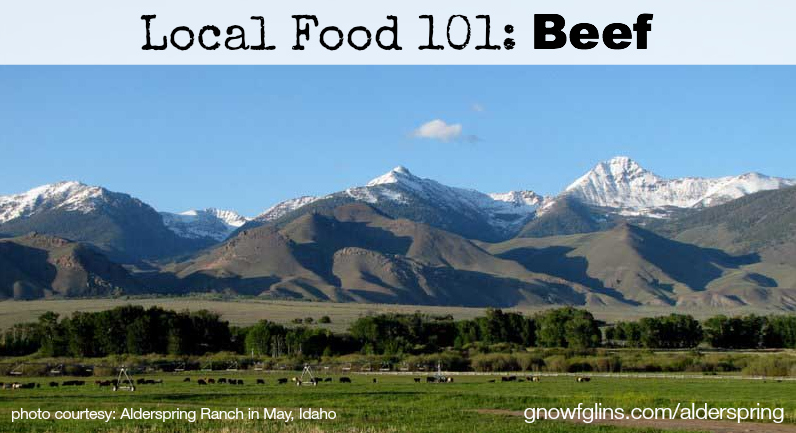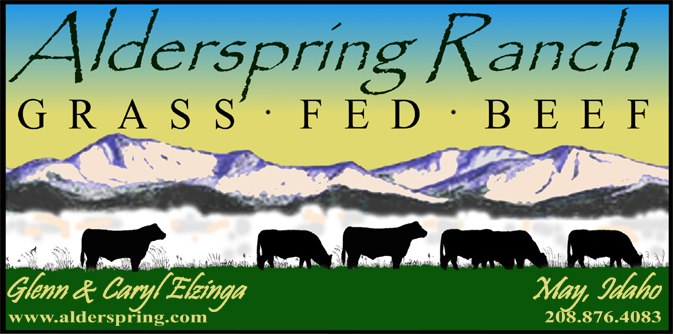Knowing your food and your farmer. We talk about this, but why is it important? So you can support farmers who practice sustainable agriculture that improves the land, soil, and animal health; to provide healthy nourishment for your and your family; and ultimately to glorify our Creator through our recognition and pursuit of food systems that honor His design.
But how can you know if a particular food source is a wise and healthy choice? You start by talking to the farmer who produces it, asking questions that pertain to the type of food you’re buying.
This is the Local Food 101 series, where we’ll cover types of local food, along with the particular questions you can ask to determine the quality of the food being offered. Last time, we discussed chickens and eggs, and this time, we’ll tackle beef.
This post does not cover raw milk; if you’re interested, you can learn more about that here.
Grain or Grass
How are the cows fed?
In commercial animal feeding operations, cows are crammed into tiny spaces. They often stand in excrement and have little, if any, access to sunlight and pasture. The problem is, even in this unfortunate scenario, cows can be classified as “grass-fed” as long as they’ve spent a little of their time outdoors. We want to make sure the beef we buy has had almost total access to pasture during its lifetime. Conventionally raised cows, on the other hand, are fed GMOs and pesticide-ridden grain, which causes a whole host of health problems for us and for the animals.
Much more information about the health benefits of grass-fed and pastured meats can be found here.
How do you manage your cows’ pasture?
Many in the know would argue that the healthiest method of grazing cows is to rotate the herd in a group (or “mob”) to fresh pasture every day. This is called “mob stocking” or “managed rotational grazing”. The area should be large enough for cows to eat it down in a full day, but not too large so that the cows pick their favorite grasses to eat and leave all of the others. Also, it should contain a well-rounded variety of grazing plants. It’s the proverbial “eat your peas and carrots!” for cows. 😉
When the cows are moved to a new pasture, the grass should be fairly tall and at the juvenile stage of growth. Good farmers understand that this stage of grass provides the most nutrition for their cows.
Get more info about mob stocking or managed rotational grazing in these books: Salad Bar Beef by Joel Salatin and Comeback Farms by Greg Judy.
What about winter?
If cows are on pasture all the time, the grass grows greener and earlier than other surrounding farms because it is so healthy. I was blessed to witness this during an early April tour at Polyface Farms in southern Virginia. The surrounding pastures were still very brown with little grass growth, but at Polyface the cows had been grazing for weeks on bright green grass! It was incredible to see the drastic difference between the property lines. If farmers follow good rotation methods, their cows have earlier and extended access to pasture during the year. During the times without access, the cows should be fed locally-grown hay.
Butchering
How old are your cows when they are butchered? What butcher do you use, or do you offer a choice of butchers? How are they processed/handled? Is the meat “sanitized” or given ammonia baths?
Different butchering methods greatly affect the taste of your beef. Most farms cannot butcher cows themselves because of the legal regulations and the sheer size of the cows. So if you want yummy beef, it’s very important to have a knowledgeable butcher.
If your farmer gives you a choice of butchers, but you’re not familiar with them, ask around to get opinions on the quality of the processing. We’ve had very “gamey” beef become delicious and tasty when the butcher was changed. You also need to know if the meat has been treated with chemicals, such as ammonia baths, so you can avoid ingesting them.
Is the meat aged at all, and if so, for how long and under what conditions?
Regarding aging, there are wet and dry aging practices. According to Alderspring Ranch in Idaho (raising some of the best organic, grass-fed beef around), during dry aging “a carcass is hung for 14 to 21 days in a locker where temperature (34 to 35 degree Fahrenheit), ventilation, and humidity (85%) are carefully controlled. During this time the beef loses excess moisture, becomes tender, and develops flavor.”
And here’s more from Alderspring Ranch about how dry aging compares to wet aging, and why dry is preferred:
“Dry-aging is very time consuming and expensive, requiring extra effort, storage, excellent facilities, and high-quality beef. Up to 5% of the original weight of the carcass is lost during the dry-aging process. This is why dry-aged steak is offered only in fine restaurants, upscale grocery stores and gourmet steak companies.
Instead of dry-aging, most of today’s “aged beef” undergoes the wet-aging process. The fresh cuts of meat are vacuum-packed in plastic bags, and are allowed to sit at temperatures between 34 to 38 degrees Fahrenheit for 7 to 28 days. In this hermetically sealed environment the meat ages in its own juices, hence the term “wet-aging.” Since the meat is packed in its own juices, the enzymes will break down the connective tissues and make it more tender. However, because there is no fluid loss, wet-aged meat lacks the concentration of flavor that results from dry-aging.
Wet-aging does not require a facililty that allows for long-term hang-drying of individual sides of beef without them touching each other. The meat is packed soon after processing, and requires much less storage space, doesn’t require careful humidity controls and constant checking, and results in no loss of weight. These economic reasons explain why over 99 percent of beef — including the meat used at many well-regarded steak houses — is wet-aged.”
Cost
Do you offer discounts for bulk portions of a cow? If so, can I select my cuts?
If you buy a quarter, half, or whole cow, you will often get steep discounts from the farmer. Many farms even give you a choice of how you want you want your beef processed — steak cuts, roasts, stew meat, ground meat, and other cuts — if you order such a large amount. (You may be able to specify this info with the farmer, or you may have to communicate with the butcher directly.)
If purchasing this way (a quarter or more of a cow), your per pound price is usually calculated on the “hanging weight”, which is the meat gutted and skinned, but before it’s cut up and processed. So around 1/3 of it is bones and non-meat. In addition, you may also get additional charges from the butcher — perhaps a slaughter/kill fee and then the customary per pound processing. Sometimes the farmer calculates these charges into the price he gives you (meaning he then reimburses the butcher), but sometimes you pay the farmer and the butcher separately.
In addition to discounts on large orders, at butchering time, farmers will often discount advance or extra large orders even further. At this time, the farmers have a limited amount of freezer/fridge space, so they may discount you if you take your order off their hands quickly.
And some ranches are also able to sell steaks, roasts, ground, and other cuts per package (much like at a grocery store) — the price is likely to be higher per pound because the processing would have to be done at a facility that’s licensed to process meat for retail sale.
Prices vary widely, as you can see in this informal survey we did here at GNOWFGLINS a few years ago.
Can I keep the bones, organs, and/or fat?
Think about whether you want to keep the bones (for stock), organs (for nutrition) or fat (to render into tallow). Not many people ask for this and if you want them, you need to communicate your preferences before the meat is processed. Sometimes grass-fed beef is so lean, saving the fat isn’t an option.
Many farms will also give organ meats or stock bones away at steep discounts since there is less demand for them.
What other questions would you ask a farmer about their beef?
If you don’t have many (or any) options for local grass-fed beef, check out Alderspring Ranch’s organic, grass-fed beef — raised on mineral-rich, high pastures in rural Idaho but available across the country through online ordering. Due to their remote location, “local” for them is across the country.
We only recommend products and services we wholeheartedly endorse. This post may contain special links through which we earn a small commission if you make a purchase (though your price is the same).




This is great Jenny! Thank you. We just found another local source nearby and other than it being grass fed and hormone free. I didn’t really know what else to ask or why.
Value-adding info, Jenny! A friend of mine raises grass-fed water buffalo 5 minutes from my house. He’s quick to correct folks that call him a grass-fed water buffalo farmer by saying that he’s a grass farmer. 😉
We just bought half a beef from a local farm, and it is wonderful meat. The farm has been in the same family for over 100 years, and the animals are born, raised and go direct to slaughter from there. They are on pasture year-round. The animals are slaughtered off-farm, hung for a minimum of 14 days, then go back to the farm to be cut and processed. We got the soup bones, tallow and liver. Since I live alone, we split it between my two sons and their families and me. I find particular satisfaction in not only having wonderful meat at a great price ($3.85/lb hanging weight was total price), but also in supporting a local family.